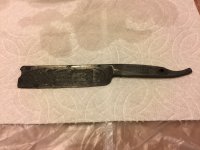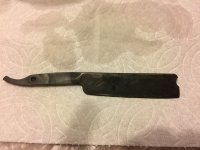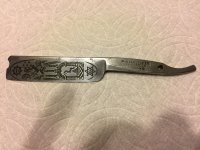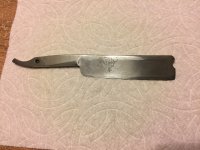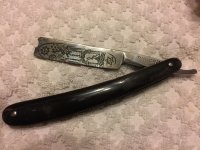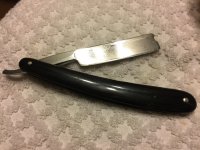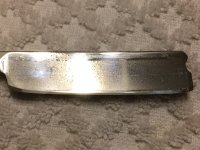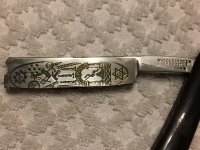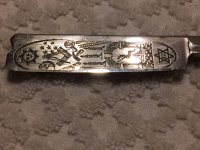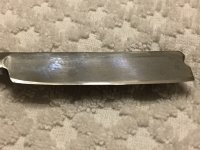Hello ya'll,
I recently got a razor from a friend since he knew I liked straight razors, but there was a bit of rust all over the blade and the scales were so holy at this point, I had to remove them and will dispose of them. This is what they look like without the scales:
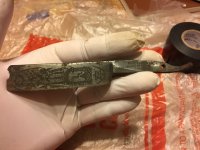
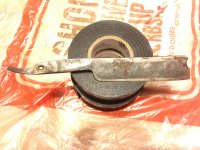
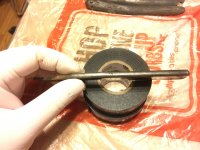
My initial plan to improve the condition of my razor (after some research on the threads) was to:
1.) Use Evapo-rust to remove the majority of the red rust, hopefully without removing too much of the black material (magnetite?) from inside the engravings or damaging the engraving themselves.
Quick question: Does Evapo-rust damage the blades or change the carbon makeup of the steel? This would be important to know before using it or thinking of another solution (e.g. white vinegar, etc.). The reason I chose Evapo-rust because I saw it on a previous thread on B&B similar to mine and it seems to be safe to use and had good reviews online. I also chose to use a chemical rust remover first prior any physical means of rust removal because I want to assess the level of damage on the blade before doing anything I might regret.
2.) At this point, two possibilities depending on the level of underlying rust and pitting:
2a.) If the blade is still deeply rusted or significant pitting was found, I was going to use hand sanding using a similar progression to the one found on this sticky thread.
2b.) If the rust was mostly surface without significant pitting, I was going to either sand with high grit (1000+) only or use Super fine 0000 steel wool to help remove any lingering rust and small pits from blade.
- For both, I will use a nail polish barrier (approximately 2-3 coats) over the engravings I want to protect while I sand the blade. I purchased a micro-diamond and titanium formula polish so it should hopefully hold up well during this process. (See here for what I'm using). I will also try to avoid doing any heavy work around the bevel to not damage the edge or cause a chip.
3.) I will finish with a metal polish cream to make it hopefully shine a bit. It took me a bit to find suggestions on this, but I settled on using either MAAS (Why do they have a french lavender formula??) or Simichrome to polish my blade, depending on what you guys think. I have both coming in the mail so I could go either way.
I'm not sure how gentle the metal polish would be on the engravings, but if I have to I can use another coat of the nail polish to protect things if need be. Your thoughts?
4.) Once the blade is restored somewhat, I'm looking for somebody with experience in honing a wedge blade without costing me an arm and a leg and hopefully wouldn't hone over my engravings. Takers?
5.) After all these steps, I will pin some nice looking horn scales onto this blade myself, make adjustments as necessary.
With this thread, I hope to get some good advice on restoring this great piece of wet shaving history and I want to also get some restoration experience under my belt. I also hope that this thread helps somebody else out there that is looking to work on blades with extensive engravings like this one.
I will continue to add posts to this thread with new pictures of my progress as I work on this razor; right now, I'm waiting for my metal polish creams and bottle of Evapo-rust to come in the mail before I do anything, but please give me your advice/tips on working on this blade and thanks for your advice in advance!
I recently got a razor from a friend since he knew I liked straight razors, but there was a bit of rust all over the blade and the scales were so holy at this point, I had to remove them and will dispose of them. This is what they look like without the scales:



My initial plan to improve the condition of my razor (after some research on the threads) was to:
1.) Use Evapo-rust to remove the majority of the red rust, hopefully without removing too much of the black material (magnetite?) from inside the engravings or damaging the engraving themselves.
Quick question: Does Evapo-rust damage the blades or change the carbon makeup of the steel? This would be important to know before using it or thinking of another solution (e.g. white vinegar, etc.). The reason I chose Evapo-rust because I saw it on a previous thread on B&B similar to mine and it seems to be safe to use and had good reviews online. I also chose to use a chemical rust remover first prior any physical means of rust removal because I want to assess the level of damage on the blade before doing anything I might regret.
2.) At this point, two possibilities depending on the level of underlying rust and pitting:
2a.) If the blade is still deeply rusted or significant pitting was found, I was going to use hand sanding using a similar progression to the one found on this sticky thread.
2b.) If the rust was mostly surface without significant pitting, I was going to either sand with high grit (1000+) only or use Super fine 0000 steel wool to help remove any lingering rust and small pits from blade.
- For both, I will use a nail polish barrier (approximately 2-3 coats) over the engravings I want to protect while I sand the blade. I purchased a micro-diamond and titanium formula polish so it should hopefully hold up well during this process. (See here for what I'm using). I will also try to avoid doing any heavy work around the bevel to not damage the edge or cause a chip.
3.) I will finish with a metal polish cream to make it hopefully shine a bit. It took me a bit to find suggestions on this, but I settled on using either MAAS (Why do they have a french lavender formula??) or Simichrome to polish my blade, depending on what you guys think. I have both coming in the mail so I could go either way.
I'm not sure how gentle the metal polish would be on the engravings, but if I have to I can use another coat of the nail polish to protect things if need be. Your thoughts?
4.) Once the blade is restored somewhat, I'm looking for somebody with experience in honing a wedge blade without costing me an arm and a leg and hopefully wouldn't hone over my engravings. Takers?
5.) After all these steps, I will pin some nice looking horn scales onto this blade myself, make adjustments as necessary.
With this thread, I hope to get some good advice on restoring this great piece of wet shaving history and I want to also get some restoration experience under my belt. I also hope that this thread helps somebody else out there that is looking to work on blades with extensive engravings like this one.
I will continue to add posts to this thread with new pictures of my progress as I work on this razor; right now, I'm waiting for my metal polish creams and bottle of Evapo-rust to come in the mail before I do anything, but please give me your advice/tips on working on this blade and thanks for your advice in advance!

